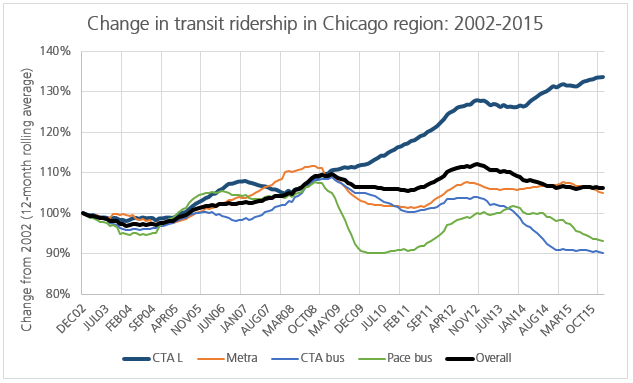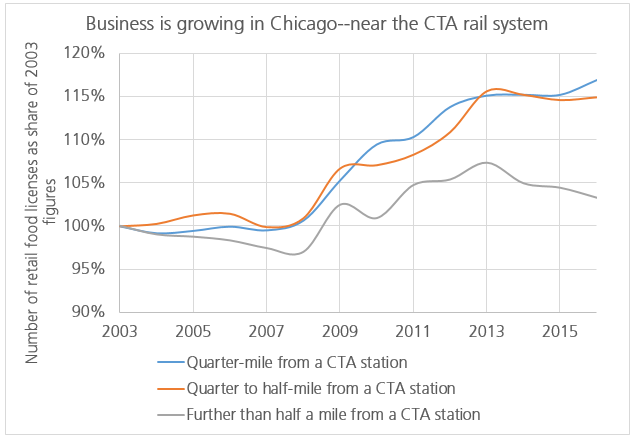
Flickr user Steven Vance (CC)
Chicago may not be growing much, but activity is increasing in areas near transit.
Published monthly, MPC’s Talking Transit, supported by Bombardier, provides updates about transit-related activities around the world. Read In the Loop for the latest transportation headlines.
Did you know?
In 2015, the Chicago Transit Authority (CTA) set a ridership record, carrying 241 million riders over the course of the year, the highest figure for Chicago’s elevated trains in decades. For many passengers—especially those riding the packed North Side Blue, Brown and Red Lines—this increase was unsurprising. With standing-room-only crowds at peak times, CTA’s trains are incredibly popular.
And yet even as the CTA was setting ridership records, the city itself was losing population, according to new estimates released by the U.S. Census Bureau. What gives? Why would train travel be becoming more popular even as fewer people are living here?
Chicago’s slow growth
The Census figures released last week offer estimates about population growth for municipalities around the country. They allow researchers to compare how the demographics of cities have changed, and to make conclusions about trends in population, but they are not definitive because they are estimates, not full counts (unlike the decennial Census figures produced every 10 years).
Even so, these data are useful to help understand how and where Americans are living. As the following chart shows, for the first time since 2010, the city of Chicago is estimated to have lost population between 2014 and 2015. This almost-3,000-person loss was the second-largest in the country after Detroit. It’s similar to changes other Rust Belt cities, such as Baltimore, Buffalo, Cleveland, Pittsburgh and St. Louis, have recently seen.

Chicago's population has grown from 2010 to 2015.
Over the past five years, Chicago’s population has grown—it had more than 20,000 more people in 2015 than it did in 2010—but that growth, at just 0.9 percent, was remarkably small compared to other cities around the country. Based on current trends, Chicago will lose its ranking as the nation’s third-largest city to Houston in 2029.
Though growth in sprawling Sunbelt suburbs continued quickly, many cities with dense urban grids like Chicago’s did too. Between 2010 and 2015, New York City gained more than 350,000 people (and is on track to reach 9 million inhabitants by 2025) and Los Angeles upped its population by more than 170,000. Places like Denver, Seattle and Washington recorded double-digit percentile increases in population despite being hemmed in by physical barriers. In other words, these cities grew through infill, not subdivisions.
An increase in ridership on some types of transit
As noted at the beginning of this article, this slow-going population trend has occurred at the same time as CTA rail ridership has increased dramatically. Indeed, as the following chart demonstrates, even as population in the city of Chicago remained basically flat over the past five years, ridership on the CTA’s rail lines increased by a remarkable 15 percent. There was a dip in 2013 corresponding to the shutdown of the south side of the Red Line (to reconstruct it), but otherwise system use has been on the up and up.
Though the CTA rail system serves certain of the region’s suburbs as well as the city of Chicago, the vast majority of its ridership—and even more of its recent growth—has been in the city, suggesting that this comparison is appropriate.

More and more people are using CTA rail lines, even as population growth flags.
The recent trend of increasing ridership on the CTA’s elevated lines is an extension of years’ worth of changes. Between 2002 and 2015, CTA train ridership increased by more than 30 percent.
At the same time, though, transit ridership in the Chicago region as a whole didn’t increase by much. Though it peaked in 2012, over the past three years, it has declined slightly and in fact is now only roughly seven percent higher than it was in 2002.
As the following graph illustrates, the region’s loss in ridership was largely driven by declines in trips taken on CTA and Pace buses. Each of those services now carries about 10 percent fewer people than they did fourteen years ago, bringing the system-wide transit average down.

Ridership growth on CTA rail lines outpaces growth on all other lines.
Why are more riders taking the train even as fewer people live in the city?
There are a few potential explanations for how ridership on CTA rail lines is growing even as population declines. One is that more of the city’s residents are choosing to ride transit instead of drive to work. As I documented in a previous edition of Talking Transit, between 2006 and 2014, all of the increase in commuters in the city of Chicago was absorbed by transit, biking and walking even as the number of drivers declined. In other words, ridership is growing because a higher share of local residents are choosing to make train riding part of their daily lives.
Another explanation is that people are getting off the bus and into trains. Since 2002, overall CTA ridership—including buses and trains—has grown by only about 6 percent, indicating that the rail system’s growth is coming at the expense of the bus system. As Daniel Kay Hertz has written, that change may be a consequence of the CTA—like many other transit agencies—making the strategic choice to concentrate limited operating funds on the rail system rather than buses. The result is poorer bus service and, ultimately, less ridership.
A final explanation is that, even if population growth is steady or declining for the city of Chicago overall, it is increasing in areas adjacent to the CTA rail system. Because U.S. Census data at the neighborhood level is not yet available for 2015, we do not have concrete evidence for this, but recent construction in the city suggests that this may be occurring. In fact, of $6.5 billion in new construction building permits in the city since the beginning of 2015, more than 75 percent were in areas within a half-mile of a CTA rail station. For comparison, only 51 percent of people who live in the city live within a half-mile of a station. This suggests that there is growth, just near transit, as other neighborhoods may be losing population.
Additional data on business permits supports this argument further. Using data from the City of Chicago’s open data portal, I examined all retail food licenses (which are generally required for restaurants and grocery stores, and which are representative of overall business) awarded in the city and identified how close they are to the CTA rail system. As the following graph shows, while the number of licenses increased by about 15 percent between 2003 and 2016 in areas within a half-mile of a CTA station, the number of licenses further from stations increased by less than five percent.
Since 2013, the number of food licenses near transit has grown even as it has declined far from the CTA rail transit system.

Transit as a tool for growth
Chicago has an incredible asset in its CTA rail system. Thanks to frequent and fast service that gets people between the destinations they’re interested in, the CTA system is attracting more and more riders and, it appears, attracting not only more population growth but also more business activity.
The Metropolitan Planning Council’s Grow Chicago initiative is working to do even more to encourage this growth, which can help cut congestion and pollution all the while increasing social equity. Recent trends suggests that transit is the selling point for a competitive, growing city, and Chicago should do as much as possible to encourage the further development of neighborhoods around our transit lines through transit-oriented development.